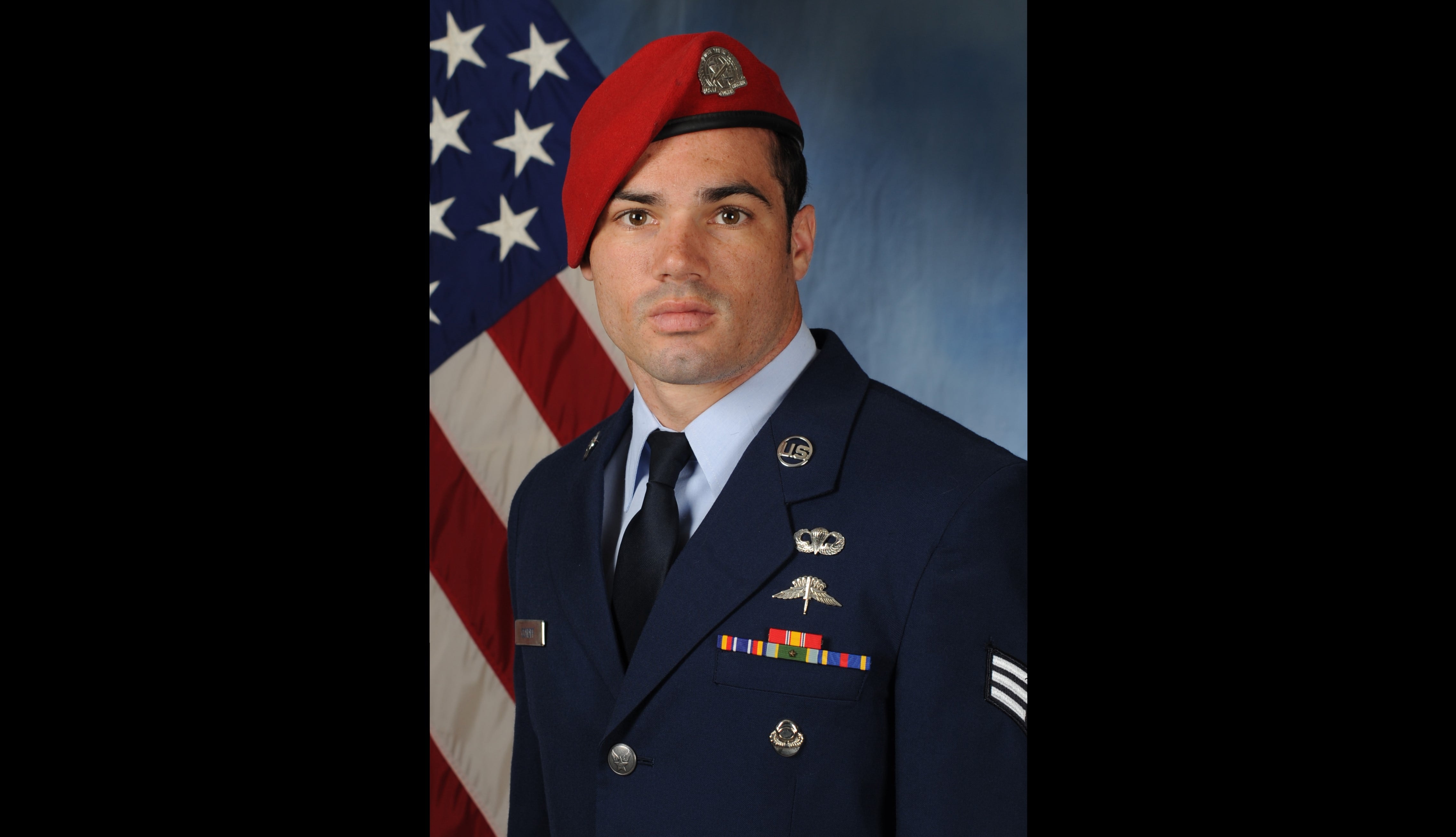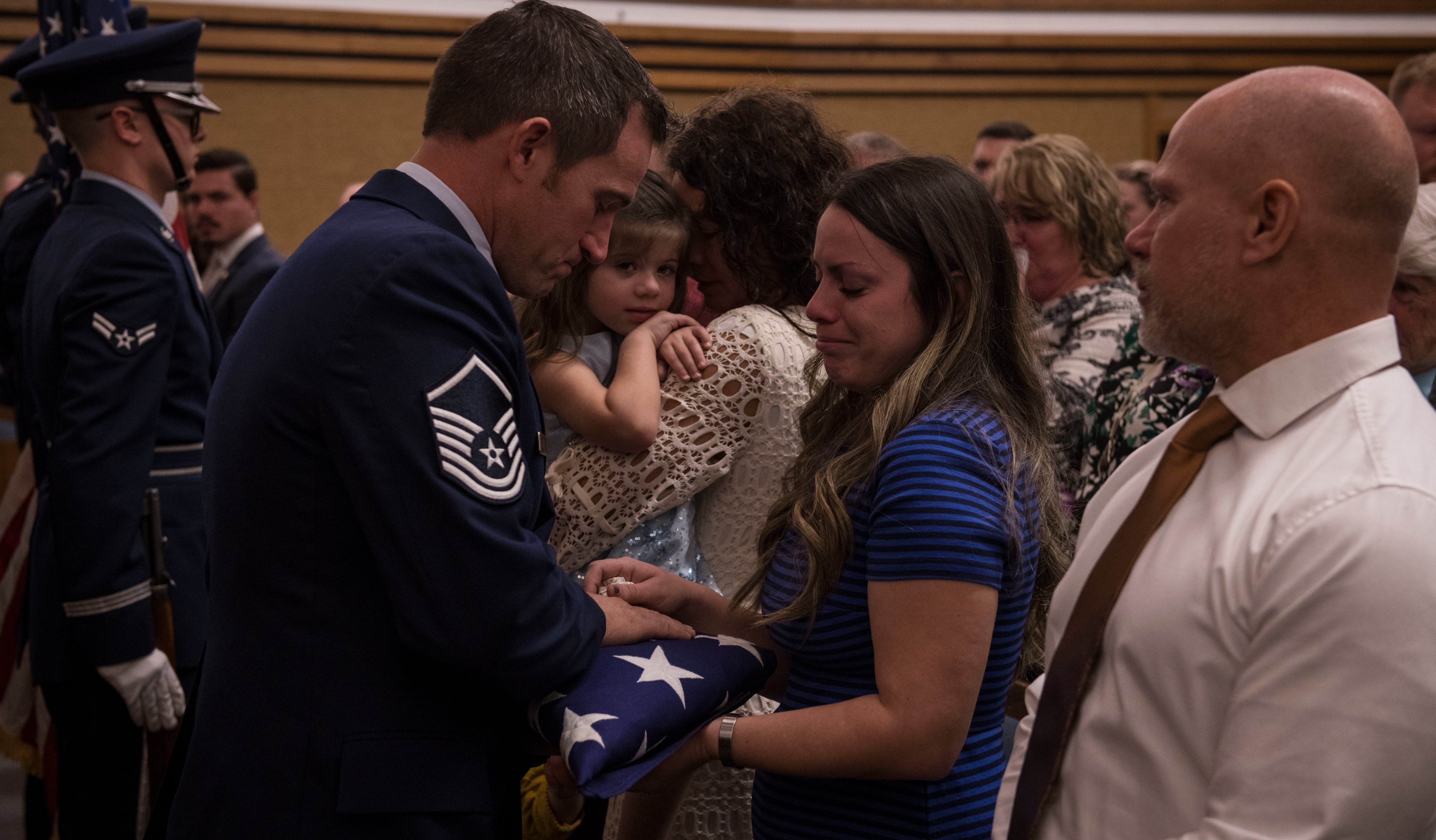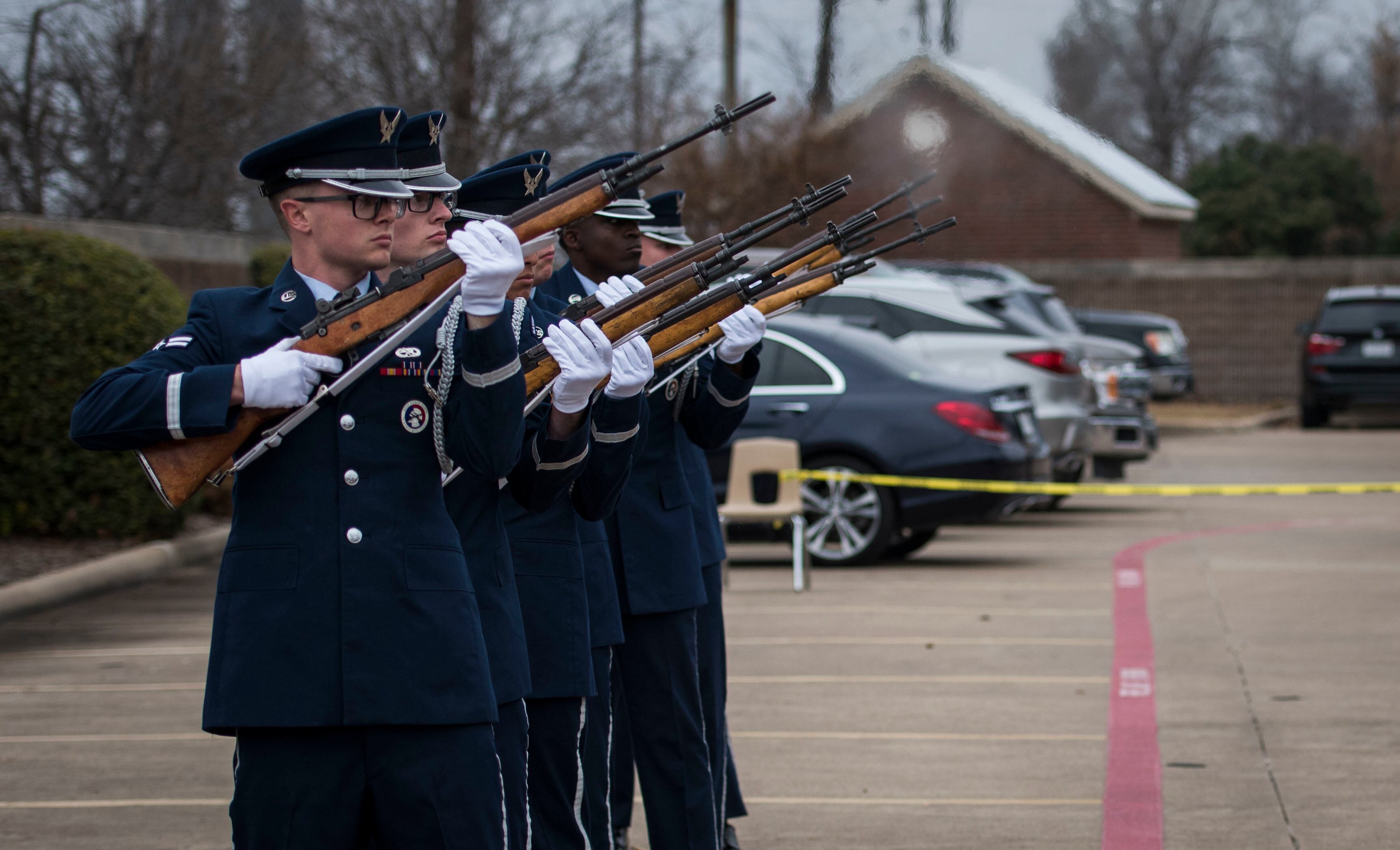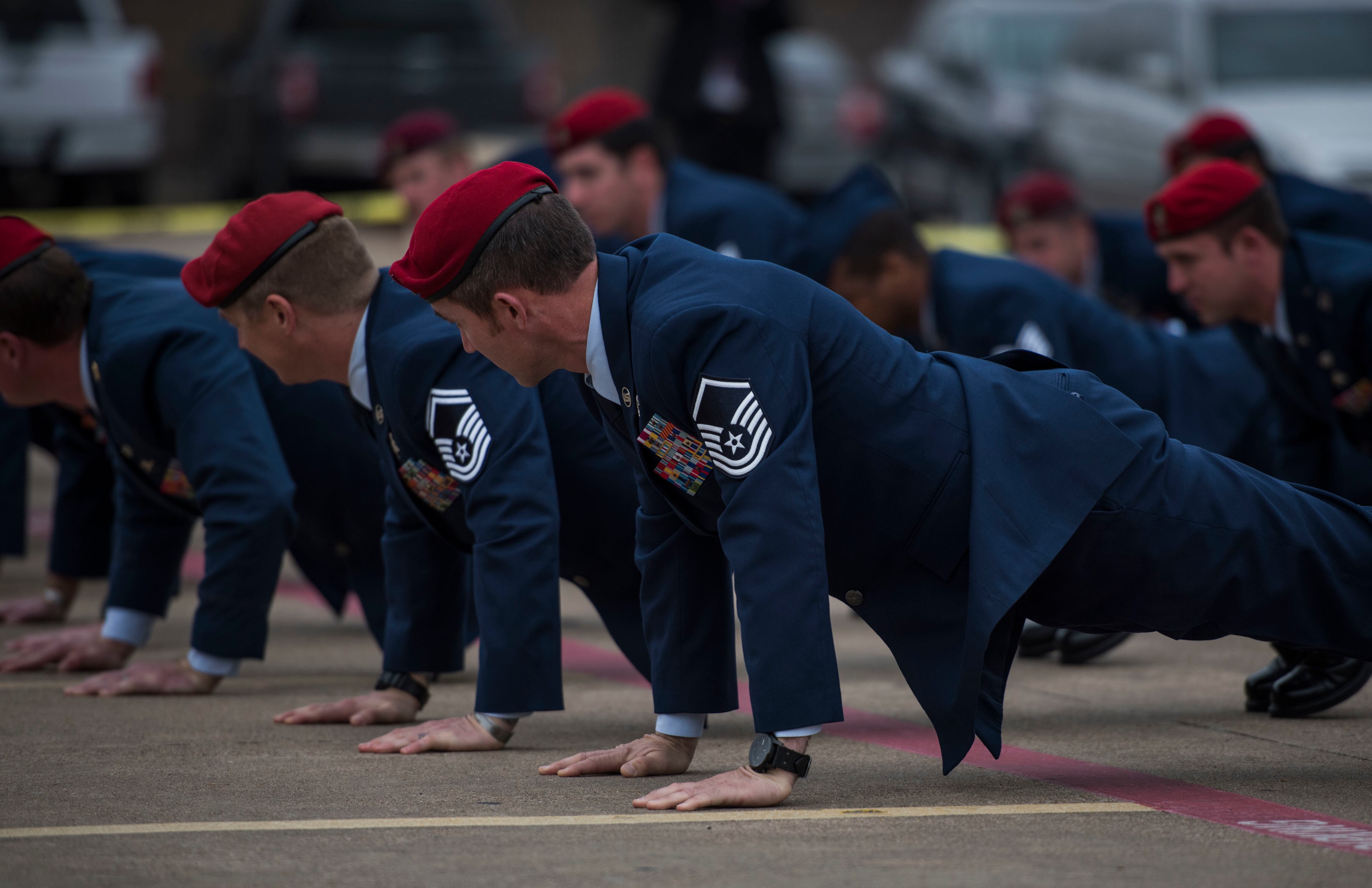The wind rushed past Staff Sgt. Cole Condiff as he stood in the doorway of an MC-130H Combat Talon II, traveling 150 miles per hour about 1,000 feet above the waters of the Gulf of Mexico.
It was a little after 11 a.m. last Nov. 5. Condiff, an experienced combat controller and jumpmaster who had deployed to Africa and Afghanistan, was getting ready to help guide a team of airmen on training jumps as part of an event called the Special Tactics Rodeo, hosted by the 24th Special Operations Wing at Hurlburt Field, Florida.
With his static line clipped to the plane, Condiff rose up on his toes and leaned slightly out of the doorway — possibly to get a better look as they approached the drop zone. He then returned to a neutral standing position, hands on either side of the door frame.
But there was a problem — a small detail that within seconds would lead to the death of Condiff, a Texas native, husband and father of two young daughters. A pair of “tuck tab inserts” — pieces of fabric meant to keep a T-11R reserve parachute from accidentally deploying — were not inserted all the way in Condiff’s chute.

A blast of 150 mile-per-hour wind hit Condiff, catching loose fabric under the ripcord handle of his reserve chute — which the insert tabs were meant to prevent — and deploying the chute.
The wind furiously whipped the chute back along the plane’s fuselage. As it yanked his chute back, Condiff slammed into the door frame hard enough to scratch and dent it — likely sustaining fatal injuries in the process — and was dragged out of the plane. He parachuted down to the ocean, soon went under the surface and was lost.
But the accident investigation board report, which the Air Force released Tuesday, showed that the mistake that led to Condiff’s parachute being improperly configured and that caused his death was not uncommon in Air Force Special Operations Command’s 24th Special Operations Wing.
The investigation uncovered broader problems within the Air Force special tactics community — what leaders called its “culture of complacency” on risk acceptance and reduced emphasis on training standards, which led to Condiff’s death. This lack of leadership was among the other factors that substantially contributed to Condiff’s death, investigation board president Maj. Gen. Larry “Kip” Clark, AFSOC’s senior Air National Guard adviser, said in the report.
In a news release, Lt. Gen. Jim Slife, head of Air Force Special Operations Command, pointed at the extremely high operations tempo that has stressed special tactics airmen and units to the breaking point over nearly two decades.
“Our people truly are our greatest asset,” Slife said. “We owe it to them to continually evaluate how we operate and how we can be more effective.”
Condiff was with the 23rd Special Tactics Squadron, part of the 24th SOW at Hurlburt Field. He was a static-line jumpmaster, military free-fall jumper, combat scuba diver, air traffic controller and joint terminal attack controller, who enlisted in 2012. He left behind a wife and two daughters.

Gone in a second
The accident happened on the fourth day of the wing’s first Special Tactics Rodeo in more than 20 years, the report said. The esprit de corps-building exercise involved six teams from across the country.
After Condiff’s chute unexpectedly deployed and he “violently” hit the door frame, his hips and torso rotated out of the MC-130 and his legs started to arc upwards until he was dragged roughly horizontal to the aircraft. There was another loud noise, which may have been him hitting the aircraft’s exterior.
A loadmaster heard a bang, realized Condiff was no longer in the door and announced over the intercom that a jumper was being towed. But an instructor loadmaster saw Condiff’s static line was, at that point, extending out of the aircraft high in the door frame, indicating it was no longer towing him.
That loadmaster looked out the door and confirmed Condiff was gone — then looked down and saw him floating to the ocean’s surface, under both his main and reserve parachutes. He never made a radio transmission after being pulled from the plane.
The airmen on board the MC-130 quickly tried to figure out how to save Condiff. The pilot turned back toward where he fell, and the crew scanned the ocean’s surface for him. Some of the pararescuemen on board were ready to jump after him, but nobody wore life preservers, and the pilot felt that was too dangerous. He also felt it was unnecessary, since some air crew thought they saw him treading water, and rescue aircraft and boats were on the way.
RELATED

But it wasn’t until 20 minutes after Condiff fell that a civilian life flight, or medical transport, helicopter showed up and volunteered to help look for him. Coast Guard search boats arrived 10 minutes after that, and other rescue efforts followed.
Ultimately, rescue units from four branches of the military, including the Coast Guard, searched for Condiff around the clock for 17 days, first trying to save him, then attempting to recover his remains. But though they scoured more than 4,500 square miles in the northern Gulf of Mexico — scuba divers even conducted more than 100 dives — nothing except a small parachute extractor was found.
The investigation concluded that Condiff, with what were likely fatal injuries, probably submerged under the weight of his equipment and his own body within minutes.

Condiff’s family and the Air Force special tactics community deeply grieved his loss. At a memorial service in his hometown of Richardson, Texas, in December, he was remembered as someone deeply devoted to his family and his faith. Condiff was a member of the Church of Jesus Christ of Latter-Day Saints, who served a two-year mission in Spokane, Washington, after graduating from Utah Valley University.
His widow, Rachael, was presented with a flag at the memorial.
Condiff “made me a better man,” an unidentified teammate said in a release about his funeral. “He made us all better.”
His father, Todd Condiff, called him a “loving and caring father, husband, brother, uncle and son,” who “was taken a little too early for us.”
“He died doing what he loved, and he loved his brothers in the Air Force,” Todd Condiff said.
In July 2018, as Rachael was pregnant with their second daughter, Condiff had an emotional surprise reunion with his wife and first daughter at a Washington Nationals game, just four days before his daughter’s third birthday.
Training shortfalls
The report outlined a range of institutional problems with AFSOC that led to Condiff’s parachute not being configured correctly. Condiff and the other jumpmasters involved had “insufficient procedural knowledge” about the importance of properly placing inserts in the reserve chute, it said.
Training in the 24th SOW was lacking and led to a widespread misunderstanding of the regulatory requirements for safely when conducting static line parachute operations, the report said.
Though the Army and Navy had created guidance on properly configuring and storing the T-11R parachute, the technical order management process failed to effectively distribute that guidance to the Air Force special tactics community.
Regulations say that these chutes and their tuck tabs are supposed to be checked twice — first by a qualified jumpmaster before the mission, who is supposed to put the inserts in fully when they are needed, and again during the mission to make sure the inserts are installed correctly before a jumpmaster takes control of the paratroop door.
But the jumpmaster who inspected Condiff’s chute that day did not call attention to loose material on one of his tuck tabs, the report said, and did not put the inserts in himself. Instead, he left it up to Condiff to put in his own inserts.
Photographs of the mission showed several jumpmasters performing duties in the door with incorrectly-inserted or missing tuck tab inserts.
The investigation concluded that a wide range of people involved in the mission — event planners, safety personnel, numerous jumpmasters and jumpers — didn’t understand the regulatory requirements for safely conducting static line jumps. The lack of jumpmaster training on how to properly handle the reserve chute inserts helped cause the mishap, the report said.
“I view this widespread misunderstanding to be a training issue within the 24 SOW and not an isolated issue with particular individuals,” Clark, the investigation board president, wrote in the report.

AFSOC spokeswoman Maj. Amanda Reeves said two squadron commanders — the heads of the Special Tactics Training Squadron and the 24th Special Tactics Squadron — were removed after the deaths of Condiff and Technical Sgt. Peter Kraines, and the investigations that followed. Kraines, a pararescueman with the 24th SOW, died in an accident while conducting mountain rescue training near Boise, Idaho, last October.
The squadron commanders were not deemed culpable for the airmen’s deaths, and were not removed because of any actions they took, Reeves said. But ultimately, AFSOC decided that if the culture of the squadrons was going to change, the leadership needed to change as well.
Other administrative actions followed, she said. Some of the jumpmasters involved were temporarily decertified, she said, and five letters of reprimand were handed out. AFSOC also updated training standards, and added new positions across the wing to focus on safety, and standards and evaluations.
Wider command issues
Condiff’s death occurred less than a month after Kraines’ death. In December, Slife halted all parachuting, diving and mountaineering activities across AFSOC while the command reviewed the equipment, safety procedures and regulations for those skills. Those activities only fully resumed in May.
The review uncovered several problems with in-garrison training practices and standards, AFSOC said — not just in the 24th SOW, but the entire command.
And in a release, Slife said the high operations tempos being asked of AFSOC for two decades played a role in the degradation of its training standards and safety precautions.
“It is apparent that these losses are a tragic consequence of a culture shaped by the demands of the last 20 years,” Slife said in the release. “Across AFSOC, we normalized a culture overly focused on mission accomplishment, causing a lapse in training rigor, strict adherence to standards, and vigorous oversight of high-risk activities at all command echelons.”
U.S. Special Operations Command also completed a comprehensive review earlier this year, the release said, which also found the entire special operations enterprise has placed its ability to accomplish its missions above leadership, discipline and accountability practices.
Slife said that since 9/11, AFSOC has made training at home and giving its airmen predictable deployment schedules less of a priority than carrying out the operational missions asked of it. As a result, he said, units across the command are stressed, and leaders are accepting unnecessary risk to get those missions accomplished.
“Our airmen have always found a way to do what we’ve asked of them,” Slife said. “It is our responsibility now to improve how we resource and develop them in order to remove as much risk from their missions as possible.”
Stephen Losey is the air warfare reporter for Defense News. He previously covered leadership and personnel issues at Air Force Times, and the Pentagon, special operations and air warfare at Military.com. He has traveled to the Middle East to cover U.S. Air Force operations.





